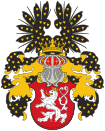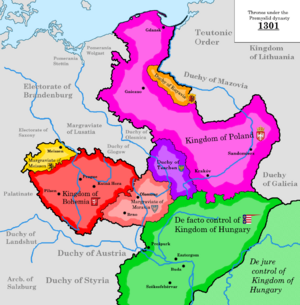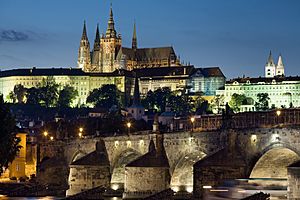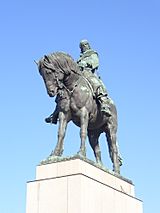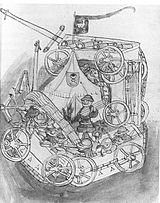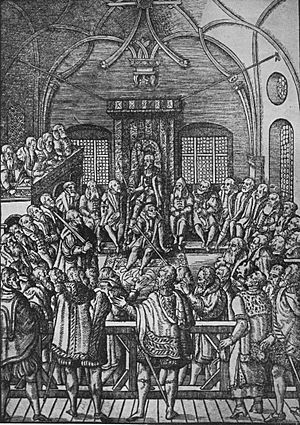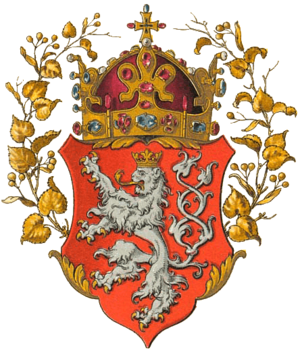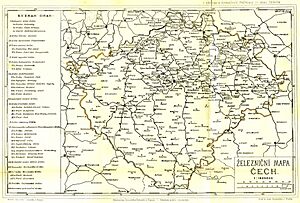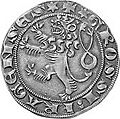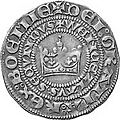Kingdom of Bohemia facts for kids
Quick facts for kids
Kingdom of Bohemia
|
|||||||||||||||||
|---|---|---|---|---|---|---|---|---|---|---|---|---|---|---|---|---|---|
| 1198–1918 | |||||||||||||||||
|
Royal coat of arms of Bohemia as a possession of Austria-Hungary (1890)
|
|||||||||||||||||
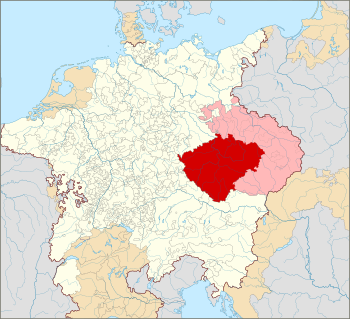
The Kingdom of Bohemia (dark red) with other Bohemian Crown lands (light red) within the Holy Roman Empire (1618)
|
|||||||||||||||||
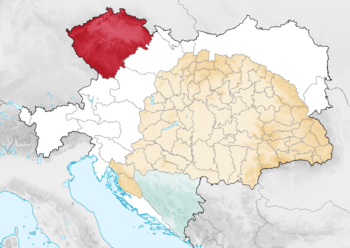
The Kingdom of Bohemia (red) within Austria-Hungary (1914)
|
|||||||||||||||||
| Status |
|
||||||||||||||||
| Capital | Prague | ||||||||||||||||
| Common languages | Czech, Latin, German | ||||||||||||||||
| Religion |
|
||||||||||||||||
| Government | Feudal monarchy Absolute monarchy Parliamentary monarchy |
||||||||||||||||
| King | |||||||||||||||||
|
• 1198–1230
|
Ottokar I (first) | ||||||||||||||||
|
• 1916–1918
|
Charles III (last) | ||||||||||||||||
| History | |||||||||||||||||
|
• Kingdom established
|
1198 | ||||||||||||||||
|
• Hereditary royal title confirmed
|
26 September 1212 | ||||||||||||||||
|
• Inauguration of the Luxembourg dynasty
|
December 1310 | ||||||||||||||||
|
• Became main part of the Crown of Bohemia
|
7 April 1348 | ||||||||||||||||
| 25 December 1356 | |||||||||||||||||
| 16 December 1526 | |||||||||||||||||
|
• Renewed Land Ordinance imposed hereditary Habsburg succession to throne
|
10 May 1627 | ||||||||||||||||
|
• Crown of Bohemia de facto dissolved
|
1 May 1749 | ||||||||||||||||
|
• Dissolution of Austria-Hungary
|
31 October 1918 | ||||||||||||||||
| Population | |||||||||||||||||
|
• Around 1400
|
Approximately 2 million | ||||||||||||||||
| Currency | |||||||||||||||||
|
|||||||||||||||||
| Today part of | Czech Republic Germany Poland |
||||||||||||||||
The Kingdom of Bohemia (Czech: České království) was a powerful monarchy in Central Europe. It existed from the 12th century until 1918. This kingdom was a key part of the Holy Roman Empire. Its king was one of the important "prince-electors" who chose the Holy Roman Emperor.
Besides Bohemia itself, the kings also ruled other areas. These included Moravia, Silesia, and Lusatia. Sometimes, parts of Saxony, Brandenburg, and Bavaria were also under their control.
The kingdom was first started by the Přemyslid dynasty. Later, other powerful families ruled, like the House of Luxembourg and the House of Habsburg. Many Bohemian kings also became Holy Roman Emperors. The capital city, Prague, was even the main city of the Empire at different times.
After the Holy Roman Empire ended in 1806, Bohemia became part of the Austrian Empire. Later, it was part of the Austro-Hungarian Empire. Bohemia kept its name and status as a kingdom until 1918. Prague remained a very important city.
The main language was Czech, especially for the government and nobles. German became more common later, but Czech became strong again in the 1800s. After World War I, the Kingdom of Bohemia ended. It became the main part of the new country called Czechoslovakia.
Contents
History of Bohemia
The Kingdom's Beginnings (13th Century)
Bohemia officially became a kingdom in 1198. This happened under King Přemysl Ottokar I. His royal title was recognized by important leaders, including the Holy Roman Emperor and the Pope. In 1212, Emperor Frederick II issued the Golden Bull of Sicily. This document made Bohemia a kingdom and gave it more independence.
This meant the Bohemian king did not have to follow many rules of the Holy Roman Empire. He only had to attend imperial meetings. The Emperor could no longer choose Bohemia's ruler or the bishop of Prague. Ottokar's son, Wenceslaus I, became king after him.

Wenceslaus I's sister, Agnes, became a saint. She started the Knights of the Cross with the Red Star in 1233. This was the first military order in Bohemia. Other military orders also existed in Bohemia during this time.
The 1200s were a time of great growth for the Přemyslid rulers. The Holy Roman Empire was weak, and Bohemia's neighbors were busy with Mongol invasions. This gave Bohemia a chance to become stronger.
Přemysl Ottokar II (1253–1278) greatly expanded Bohemia. He married an Austrian princess and gained control of Austria and other nearby lands. People called him "the king of iron and gold." He even founded a city in Prussia, which is now Kaliningrad.
In 1260, Ottokar defeated the King of Hungary in a huge battle. He ruled a large area from Austria to the Adriatic Sea. But later, Rudolf of Habsburg challenged his power. Ottokar lost his German lands in 1276. In 1278, he died in battle against Rudolf.
Ottokar's son, Wenceslaus II, became king. He was also crowned King of Poland in 1300. His son, Wenceslaus III, became King of Hungary. At this time, Bohemian kings ruled a huge area from Hungary to the Baltic Sea.
The 13th century also saw many German people move to Bohemia. The Přemyslid kings often encouraged this. Germans settled in towns and mining areas. They brought new skills and laws, which helped Bohemia's economy grow.
The Golden Age (14th Century)
The 14th century was Bohemia's "Golden Age." This was especially true during the rule of Charles IV (1342–1378). In 1306, the Přemyslid family line ended. After some conflicts, John, Count of Luxembourg, became the Bohemian king. He married Elisabeth, a daughter of Wenceslaus II.
His son, Charles IV, became king in 1346. Charles grew up in France and had a broad view of the world. He made the Bohemian kingdom stronger and more respected. In 1344, he made the Prague bishopric an archbishopric. This meant it was no longer under the control of Mainz. The archbishop could now crown Bohemian kings.
Charles also created the "Crown of Bohemia." This included Moravia, Silesia, and Lusatia. In 1355, Charles became Holy Roman Emperor. The next year, he issued the Golden Bull of 1356. This document set the rules for choosing the Holy Roman Emperor. The Bohemian king was one of the seven electors. Charles also made Prague the capital of the Holy Roman Empire.
Charles started many building projects in Prague. He founded the New Town and rebuilt the royal castle, Hradčany. A very important event was the founding of Charles University in Prague in 1348. Charles wanted Prague to be a global center of learning. The university had different "nations" for students from various regions.
Charles died in 1378. His son, Wenceslas IV, became king. Wenceslas was also chosen as King of the Romans. However, he was removed from the Imperial throne in 1400. His half-brother, Sigismund, later became Emperor. Sigismund was the last male ruler from the House of Luxembourg.
The Hussite Movement (15th Century)
The Hussite movement (1402–1485) was a major religious and national movement. It challenged the Pope's power and pushed for more independence in church matters. The Hussites fought and won against four crusades from the Holy Roman Empire. Many people see this movement as part of the wider Protestant Reformation.
The Hussite movement began during the reign of Wenceslaus IV (1378–1419). This was a time of conflict within the church and the Holy Roman Empire. The movement was sparked by Jan Hus, a reformer at Charles University in Prague. In 1403, Hus became the university's rector.
Hus followed the ideas of John Wycliffe from England. He spoke out against the wealth and corruption he saw in the Roman Catholic Church. He believed priests should be pure and poor. He also insisted that everyone should receive both bread and wine during communion. The Catholic Church usually only gave the bread to regular people.

Hus's followers were called Utraquists because they believed in communion "under each kind." A more radical group, the Taborites, formed later. They rejected many church rules and believed only the Bible was truly important.
German professors at Charles University wanted to condemn Wycliffe's writings. Hus disagreed and had the support of Czech students and faculty. The Czechs had fewer votes than the Germans. King Wenceslas eventually supported Hus. In 1409, he issued the Decree of Kutná Hora. This gave Czechs more votes at the university. Because of this, many German professors and students left. Some of them went on to found the University of Leipzig.
Hus's success did not last long. He spoke against selling "indulgences," which were like pardons for sins. This made him lose the king's support. In 1412, Hus was removed from the university and expelled from Prague. In 1414, he was called to the Council of Constance to explain his views. He was imprisoned and later burned at the stake in 1415.
Hus's death led to the Hussite Wars. These were decades of religious fighting. Sigismund, the King of Hungary, tried to take control of Bohemia after Wenceslas died in 1419. But he failed many times. Riots broke out in Prague. The Taborites, led by Jan Žižka, marched into the capital.
The fighting spread across the kingdom. Hussite Czechs and Catholic Germans often fought each other. Many people were killed, and many Germans fled. Emperor Sigismund led crusades against Bohemia.
The Hussite Wars often followed a pattern. When a crusade attacked Bohemia, the Hussites would unite and defeat it. Then, they would raid the lands of Catholic supporters. The Hussites fought for their religious beliefs and to protect their land. Žižka's armies attacked castles, monasteries, and villages. They removed Catholic clergy and took church lands.
After Sigismund died in 1437, the Bohemian nobles chose Albert of Austria as king. Albert died soon after. His son, Ladislaus the Posthumous, became king. During Ladislaus's childhood, Bohemia was ruled by a group of moderate Hussite nobles.
George of Poděbrady became the leader of this group. He was later elected king of Bohemia. George was not from a royal family, so the Pope and other European kings did not recognize him. George wanted to create a "Universal Peace Union" in Europe. He believed countries should work together for peace and solve problems peacefully. He also thought Europe should unite against the Turks.
In 1465, Catholic nobles challenged George. The next year, Pope Paul II excommunicated him. The Bohemian War (1468-1478) followed. George of Poděbrady died in 1471.
Later Rule: Jagiellonian and Habsburg Dynasties
After George of Poděbrady died, the Bohemian nobles chose Ladislaus Jagiellon as king. He was a Polish prince. In 1490, he also became King of Hungary. The Jagiellonian kings ruled Bohemia from Hungary, so they had little direct influence. The local nobles managed the government.
In 1526, Ladislaus's son, King Louis, was defeated by the Ottoman Turks at the Battle of Mohács. Louis died in the battle. As a result, parts of Hungary came under Turkish rule. The rest of Hungary, and Bohemia, came under the rule of the House of Habsburg. The Bohemian nobles elected Ferdinand, the younger brother of Emperor Charles V, as their new king. This began nearly 400 years of Habsburg rule for Bohemia and Hungary.
Bohemia's resistance to Habsburg rule led to the Defenestrations of Prague in 1618. This event helped start the Thirty Years' War. Bohemia's defeat at the Battle of White Mountain in 1620 ended its efforts for independence.
End of the Kingdom
In 1740, the Prussian Army took over Bohemian Silesia. In 1742, Maria Theresa of Austria had to give most of Silesia to Prussia. In 1756, Prussian King Frederick II invaded Bohemia. His army defeated the Habsburgs in the Battle of Prague (1757) and occupied Prague. Much of Prague was destroyed. However, Frederick lost the Battle of Kolín and had to leave Bohemia.
The Holy Roman Empire ended in 1806. The Kingdom of Bohemia then became part of the Austrian Empire. The Austrian Emperor also held the title of King of Bohemia. In 1867, Bohemia became a "crown land" within Austria-Hungary. The Kingdom of Bohemia officially ended in 1918. It became the main part of the new Czechoslovak Republic.
Today, the Czech Republic includes Bohemia, Moravia, and Czech Silesia. It still uses many symbols of the old Kingdom of Bohemia. These include the two-tailed lion in its coat of arms and the red-white stripes in its flag. The Prague Castle, once home to kings, is now the office of the Czech president.
Economy
Bohemia was one of the first places in Europe to become industrialized. Mining of tin and silver started in the Ore mountains in the early 12th century.
German settlers played a huge role in Bohemia's economic growth. From the 12th century, Přemyslid rulers encouraged Germans to move to certain areas. These settlers came from nearby lands like Bavaria and Austria. They brought new skills and tools, especially for farming and crafts.
In Silesia, the amount of land used for farming increased greatly. It grew seven to twenty times in many regions during the German settlement period. These settlers often moved to hills and mountains. They started mining and developed high-quality industries. These included metal works, weapon making, and beer production. Making forest glass was also a common industry for German Bohemians.
Lands of the Bohemian Crown
The main part of the Kingdom of Bohemia was Bohemia proper (Čechy). This included the County of Kladsko. The Egerland was also added to Bohemia between 1291 and 1305.
In 1348, Charles IV created the Crown of Bohemia (Koruna česká). This included several other important areas:
- The Margraviate of Moravia (Markrabství moravské). Bohemian rulers gained control of Moravia in the 900s.
- Upper Lusatia (Horní Lužice) and Lower Lusatia (Dolní Lužice). King John of Bohemia added these in the early 1300s. Later, in 1635, the Lusatias were given to the Electorate of Saxony.
- The Duchies of Silesia (Slezsko). King John of Bohemia gained Silesia in 1335. However, Maria Theresa lost most of Silesia to Prussia in 1742. Only Austrian Silesia remained.
- The northern part of the Upper Palatinate. Charles IV added this in 1355. But his son, Wenceslaus, lost it in 1400.
- The Brandenburg Electorate. Charles IV gained this in 1373. His son, Emperor Sigismund, later gave Brandenburg to Frederick I of Hohenzollern in 1415.
Other areas were sometimes part of the Kingdom of Bohemia:
- The Duchy of Austria, Duchy of Styria, Duchy of Carinthia, and parts of Carniola and Friuli. King Ottokar II of Bohemia gained these lands. But he lost them to Rudolph of Habsburg in 1278.
The modern Czech Republic is the legal successor of the Crown of Bohemia. This is even mentioned in its Constitution.
Demographics
Population in 1910
In 1910, the total population of Bohemia was about 6.7 million people.
- Most people (over 95%) were Roman Catholics.
- Smaller groups included Lutherans, Jewish people, and Calvinists.
- The main languages spoken were Czech (about 62.6%) and German (about 36.4%).
Images for kids
See also
 In Spanish: Reino de Bohemia para niños
In Spanish: Reino de Bohemia para niños




